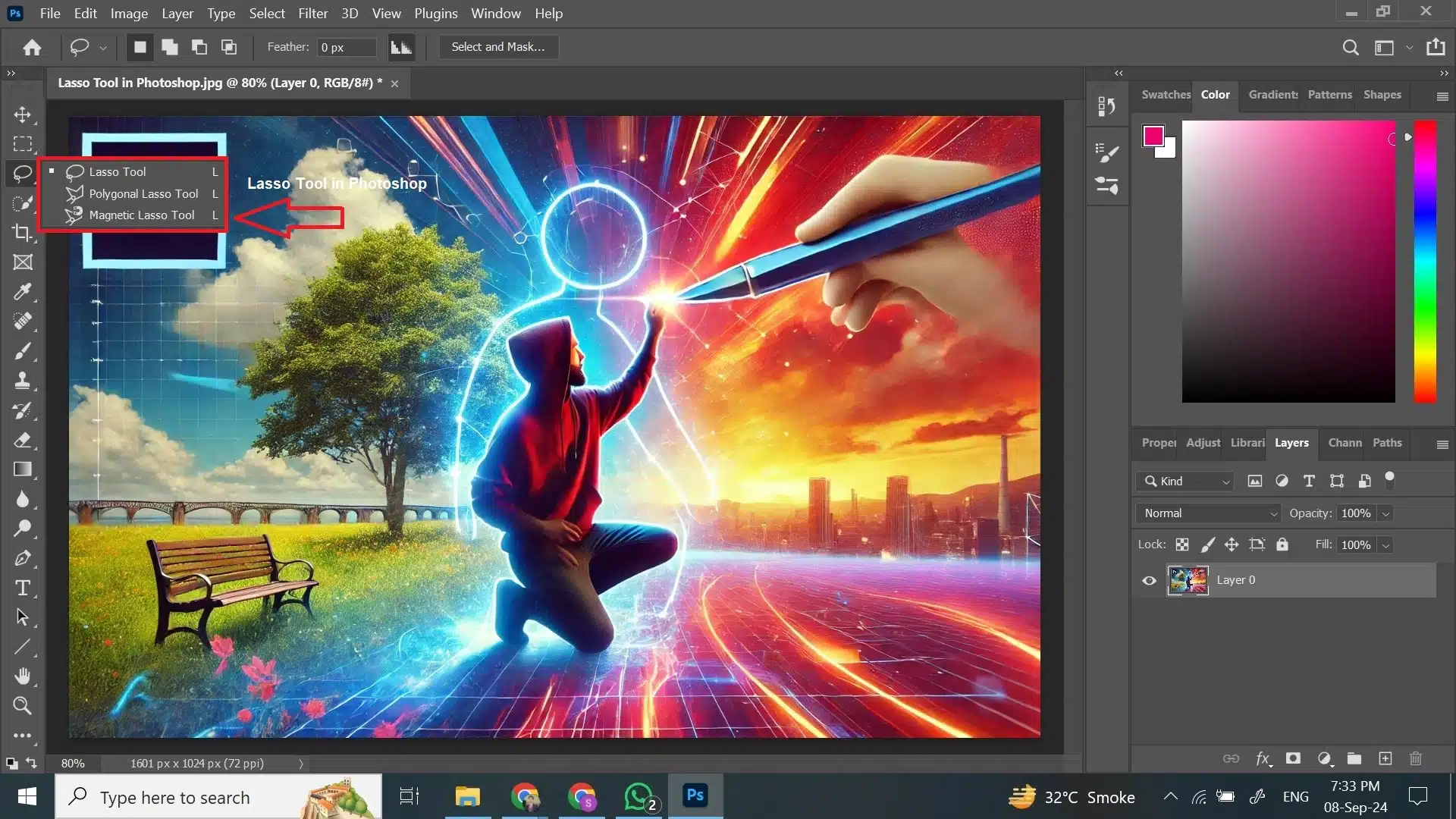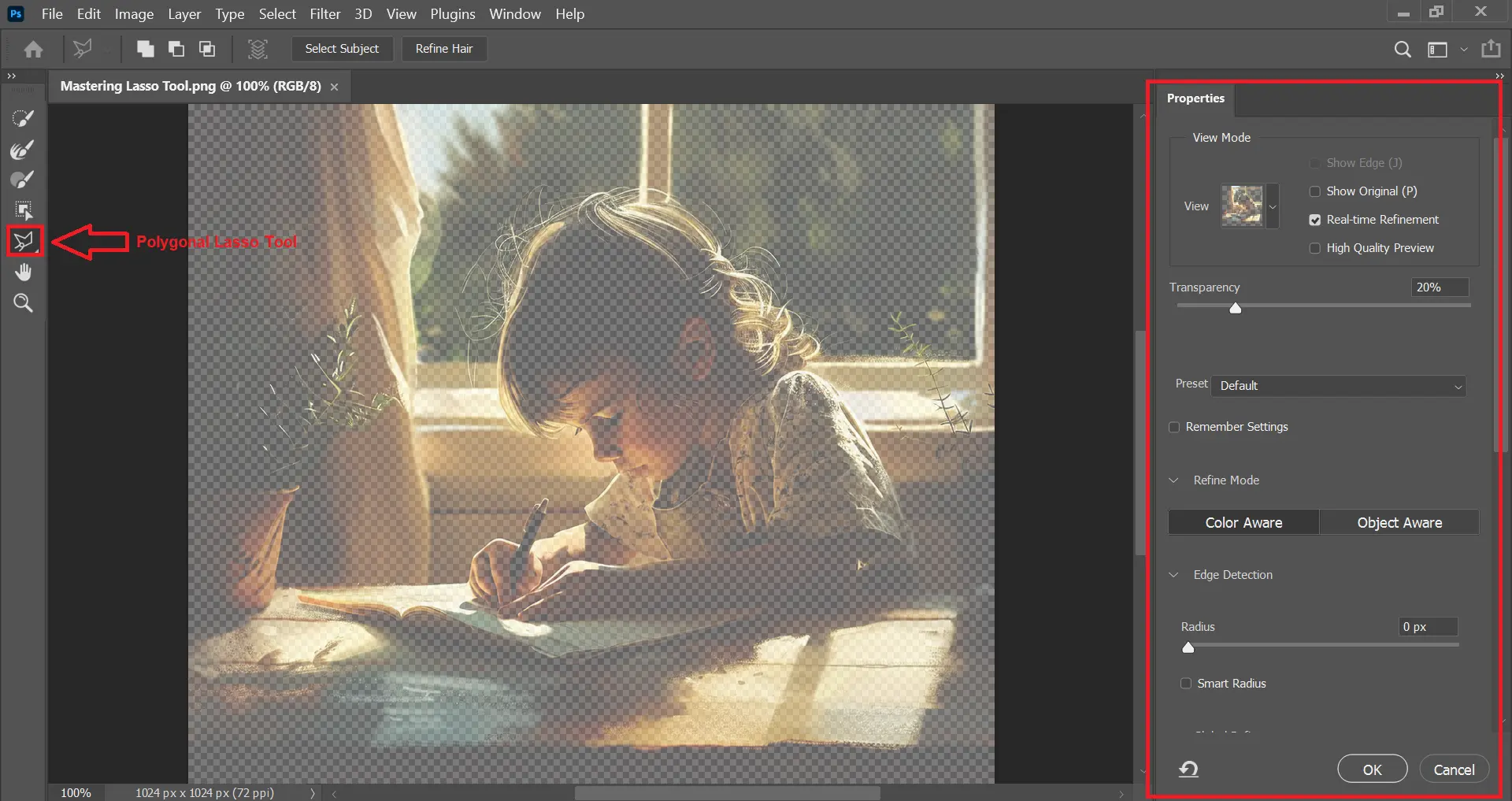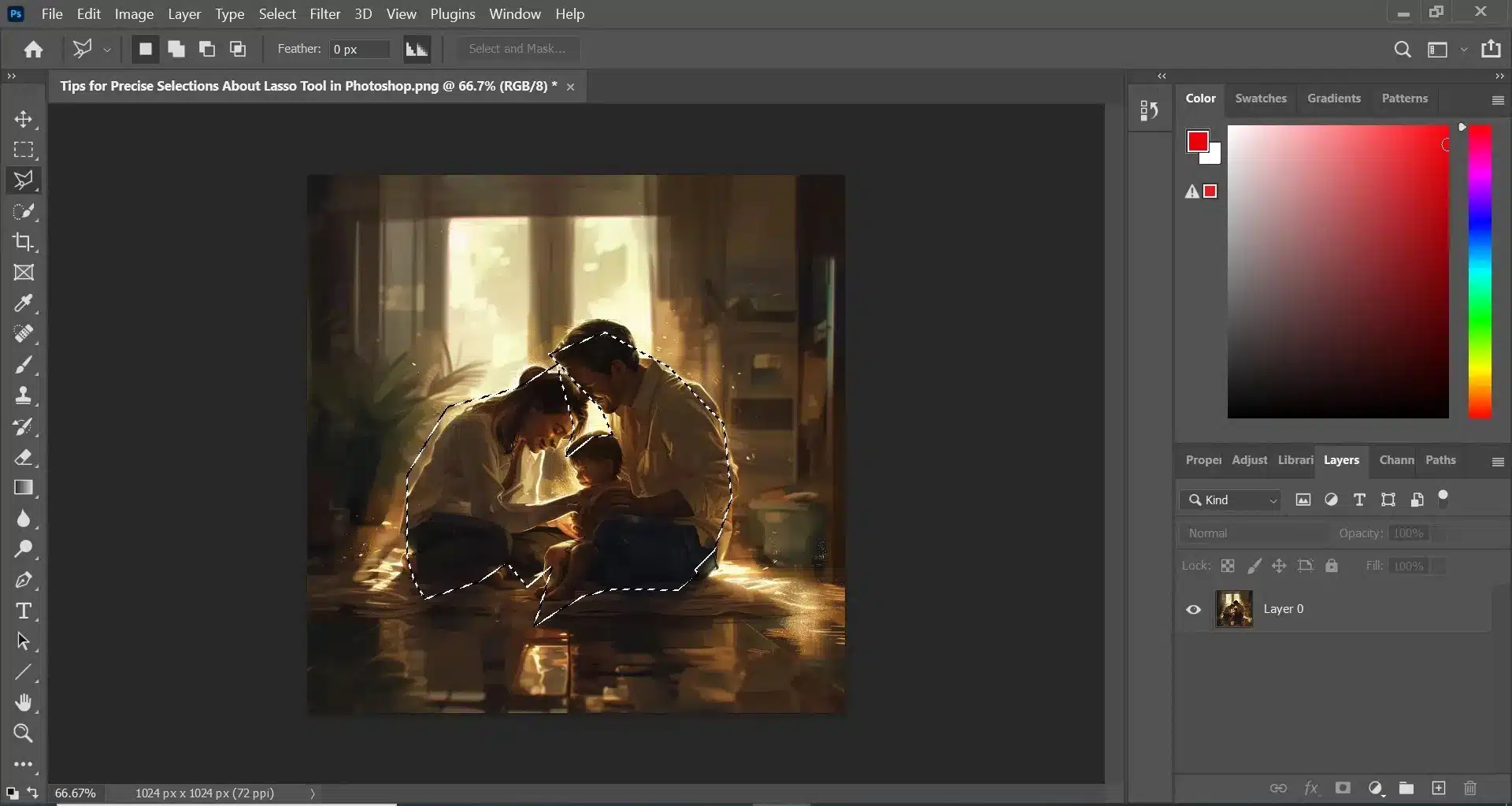
Introduction to the Lasso Tool in Photoshop
The Lasso Tool in Photoshop is a fundamental object selection tool that offers unparalleled precision and flexibility for graphic designers and photographers. Whether you are a beginner or an advanced user, mastering the Lasso Tool can significantly enhance your modification capabilities by joining the editing course. This versatile accessory permits you to outline and choose specific parts of an image, making it easier to manipulate and perfect your photos. The use of Lasso Tool is essential for tasks such as cutting out entities, making detailed adjustments, and creating complex composites.
Imagine you are editing a family photo where you want to replace the surrounding with a scenic landscape photos. Using the Lasso Tool in Photoshop, you can meticulously trace around the family members, ensuring that every detail is captured, even around intricate areas like hair and clothing. This precise choice permits you to seamlessly integrate the new surroundings, creating a professional and polished final image.
Table of Contents
Mastering the Basics of the Lasso Tool

Choosing the Lasso Tool (LT)
To begin using the Lasso Tool in Photoshop, you need to choose it from toolbar. You can quickly access it by pressing the shortcut on your keyboard. The LT icon resembles a rope loop, signifying its function to encircle and choose parts of an image. Understanding how to choose and activate this accessory is the first step in mastering its use. Once selected, you can choose between different Lasso accessories as needed for your project. Quick Selection Tool helps you to choose parts of an image quickly and easily.
Using the Standard Lasso Tool (SLT)
The SLT permits for freehand choices. Click and drag to outline the desired region of your image. This accessory is ideal for making rough choices quickly, especially when the precision of the selection is not critical. After making the initial selection, you can move the selected region by clicking inside the selection and dragging it to a new location. This ability to move and draw the selection is particularly useful when you need to adjust its position within your composition.
Employing the Polygonal Lasso Tool (PLT)
The PLT is perfect for selecting items with linear corners. Unlike the Standard Tool, you click to create points around the entity, forming a polygonal shape. This tool provides greater control and precision when working with geometric shapes or elements with defined borders. For example, it’s useful for selecting the sides of buildings or other architectural features in a photograph using the right photographic accessories.
Working with the Magnetic Lasso Tool (MLT)
The MLT is designed to snap to the corners of items automatically, making it an excellent choice for selecting complex or irregular shapes. As you drag the accessory along the border of an item, Adobe Photoshop detects the variation between the entity and the surrounding and creates a selection path that clings to the border. This feature is particularly helpful when working with items that have well-defined borders, such as a person’s silhouette against a contrasting surrounding.
Pro Tip: Familiarize yourself with Lightroom’s lasso tool as well to further enhance your workflow!
Advanced Techniques with the Lasso Tool
Combining the Lasso Tool (LT) with Layer Masks (LM)
One of the advanced techniques involves combining the LT with LM. This permits you to non-destructively hide or reveal parts of a surface without permanently altering the image. For instance, if you are working on a design where you need to remove a distracting item from beach photography, you can use the this accessory to choose the item and then apply a LM to hide it. This technique is useful when you want to make adjustments later or refine your selection over time. To add more precision, you can use a soft brush to paint on the mask, blending the corners seamlessly. If you need to transfer the mask or make further adjustments, the mask provides the flexibility to do so.
Enhancing Selections with Feathering
Feathering is essential techniques to refine your choices. Feathering softens the corners of your selection by creating a gradual transition between the chosen region and the surrounding pixels, which is perfect for blending elements seamlessly. Utilizing this option can significantly improve the quality of your edit or batch edit, especially in high-resolution images. When refining items, you can use the brush tool to fine-tune the corners, and the shift key to add or subtract areas from your items, ensuring precision and control over your portraits.
Using the Refine Edge Tool
The Refine Edge tool in Adobe Photoshop is an advanced feature that allows you to perfect your choices, especially when dealing with complex subjects like hair or fur. After making a rough selection with the Lasso Tool, you can use the Refine Edge tool to fine-tune the edges, ensuring that every strand of hair is captured accurately. This accessory is invaluable when creating professional composites, such as placing a person from a conference image into a different surface or surrounding.
Table: Key Techniques for Advanced Lasso Tool Usage
| Technique | Description | Example |
|---|---|---|
| Combining with Layer Masks | Non-destructively hide or reveal parts | Removing an entity from a seashore image |
| Feathering | Soften borders and smooth jagged lines | Enhancing the chosen part of curved or diagonal objects |
| Using the Refine Edge Tool | Perfecting choices with complex subjects like hair | Creating composites with people from a conference portrait |
| Creating Composite Images | Merging elements from different images | Placing a person from an online tutorial portrait into a beach scene |
Step by Step Guide about Lasso Tool in Photoshop
Step 1: Selecting the Lasso Tool (LT)
To start, open your image in Photoshop and choose the LT from the toolbar or by pressing the shortcut key ‘L’. The LT icon, which looks like a rope loop, will appear, indicating it’s ready for use.
Step 2: Using the Standard Lasso Tool (SLT)
Click and drag your mouse to create a freehand smart selection around the desired region of your image. The SLT is ideal for quick and rough choice of an entity. Once you’ve outlined the region, release the mouse button to complete the selection.
Step 3: Switching to the Polygonal Lasso Tool (PLT)
For more precision, especially with plain objects, switch to the PLT. Click to create anchor points along the surface of the item, and complete the selection by connecting back to the starting point. This method provides greater control over geometric shapes.
Step 4: Using the Magnetic Lasso Tool (MLT)
The MLT is perfect for objects with well-defined corner. As you drag the MLT along the corner, it automatically snaps to the border based on variation. Adjust the sensitivity in the options bar to improve accuracy.
Step 5: Refining Your Selection
After making your selection, refine it using the Refine or Select and Mask accessories. These options allow you to smooth, feather, and adjust the corner for a more polished selection. This step is crucial for integrating the selected area seamlessly into another part of your project.
Step 6: Saving Your Selection
To avoid losing your work, save your selection by going to Select > Save Selection. Name your selection and click OK. This allows you to reload the selection at any time, ensuring you can continue modifying without starting over.
Common Challenges and Solutions
Difficulty in Making Precise Selections
One of the most common challenges when using the Lasso Tool in Photoshop is achieving precise choices, especially around intricate details. To improve precision, zoom in on the area you are working on, which allows you to follow the contours more accurately. Another effective technique is to switch between the Standard Lasso and the Polygonal Lasso Tools, using linear lines to manage complex borders.
Managing Multiple Layers
Editing portraits with multiple layers can be complex and overwhelming, particularly when trying to keep track of each layer’s content. It’s crucial to label your layers clearly and organize them logically in the Layers panel. When working with this accessory, make sure you are on the correct object. This practice prevents mistakes like selecting the wrong region or applying changes to an unintended surface. Locking the layers in Photoshop you are not currently working on can also reduce errors and streamline your workflow. Using the mouse to navigate and add adjustments will improve your efficiency.
Common Issues with Magnetic Lasso Tool (MLT)
The MLT can sometimes struggle with images that have low contrast between the subject and the background. To counter this, increase the contrast temporarily by adjusting the brightness or varation settings in the Adjustments Surface. This makes the edges more distinguishable for the MLT to detect. After making your selection, you can revert/replace the color adjustments to their original settings by using Replace Color Tool, ensuring the portrait maintains its intended appearance. The option to fine-tune your adjustments in the Adjustments Surface will help achieve a cleaner selection.
Tips for Precise Selections
Zoom In for Detailed Work
Zooming in on your portrait is one of the most effective ways to ensure precise choices when using the Lasso Tool in Photoshop. By increasing the zoom level, you can closely follow the contours of your subject, making it easier to choose intricate details accurately. This method is particularly useful for fine-tuning borders and avoiding unintentional inclusions. It also provides you more comfortable and with greater control over each selection point. Discover Photoshop Skin Retouching Tutorial, a game-changer for anyone aiming to turn their portraits into breathtaking masterpieces.
Utilize Refine Edge and Select and Mask
Photoshop’s Refine and Select and Mask tools are invaluable for perfecting choices. These features offer advanced options for adjusting the corners of your selection, such as smoothing, feathering, and shifting the border. They are particularly useful for selecting hair, fur, or other fine details that are difficult to capture with the basic Lasso Tool. By fine-tuning these settings, you can achieve a clean and professional selection that integrates seamlessly into your project.
Table: Key Techniques for Precise Selections
| Technique | Description | Example |
|---|---|---|
| Zoom In for Detailed Work | Increase zoom level for close-up selection | Enhances control and precision over intricate details |
| Use the Feather Setting | Softens corners of selection | Creates natural transitions and avoids harsh borders |
| Combine Selection Tools | Use multiple tools for different parts of the selection | Efficiently handles large areas and maintains precision |
| Utilize Refine Edge and Select and Mask | Advanced accessories for adjusting selection borders | Perfects choices of fine details like hair and fur |

Frequently Asked Questions about the Lasso Tool in Photoshop
How do I use the Lasso Tool effectively?
Using the Lasso Tool in Photoshop effectively requires a combination of techniques and practice. Start by selecting the accessory from the toolbar or pressing the ‘L’ key on your keyboard. Press and drag to create a freehand selection around your desired area.
What is the lasso key in Photoshop?
The lasso key in Photoshop is the shortcut key ‘L’. Pressing ‘L’ will activate the Lasso Tool, allowing you to make freeform choices. If you press ‘Shift+L’, you can cycle through the different types of Lasso accessories, including the Standard, Polygonal, and Magnetic Lasso Accessories.
What are the different types of Lasso Tools available?
To Select the Subject, Photoshop offers three main types of Lasso Tools: the Standard Lasso Tool (SLT), the Polygonal Lasso Tool (PLT), and the Magnetic Lasso Tool (MLT). The SLT is ideal for freehand choices, allowing you to draw a selection border around your subject. The PLT is perfect for selecting objects with straight corners by creating a series of connected straight lines. The MLT automatically snaps to the corners of objects based on variation, making it easier to choose subjects with well-defined edges.
How do I modify a selection made with the Lasso Tool (LT)?
To modify a selection made with the LT, you can use the ‘Shift’ and ‘Alt’ keys. Holding down ‘Shift’ permits you to add to the existing selection, while ‘Alt’ (Option on Mac) enables you to subtract from it.
Conclusion
Mastering the Lasso Tool in Photoshop opens up a world of creative possibilities and precision in your portrait modifying projects. I remember the first time I used the this accessory; I was working on a family portrait that needed some serious retouching. By meticulously tracing around each family member and refining my choices with feathering and the Refine Edge tool, I was able to seamlessly integrate a new background, transforming the portrait into a cherished keepsake. This experience taught me the importance of patience and precision, and how mastering this accessory can dramatically improve your skills.
If you’re eager to enhance your Photoshop abilities and explore advanced techniques, I highly recommend checking out our comprehensive courses. Our Photoshop course delves deeper into the functionalities of the Lasso Tool and other essential editing tools, while our Lightroom course offers insights into organizing and perfecting your images.
Have a nice photoshoot!
Learn more about Photo Editing with Lightroom and Photoshop:

















